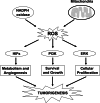Reactive oxygen species-dependent signaling regulates cancer
- PMID: 19629388
- PMCID: PMC11115800
- DOI: 10.1007/s00018-009-0099-y
Reactive oxygen species-dependent signaling regulates cancer
Abstract
Historically, it has been assumed that oxidative stress contributes to tumor initiation and progression solely by inducing genomic instability. Recent studies indicate that reactive oxygen species are upregulated in tumors and can lead to aberrant induction of signaling networks that cause tumorigenesis and metastasis. Here we review the role of redox-dependent signaling pathways and transcription factors that regulate tumorigenesis.
Figures




References
-
- Droge W. Free radicals in the physiological control of cell function. Physiol Rev. 2002;82:47–95. - PubMed
-
- Thannickal VJ, Fanburg BL. Reactive oxygen species in cell signaling. Am J Physiol Lung Cell Mol Physiol. 2000;279:L1005–L1028. - PubMed
-
- Ames BN. Measuring oxidative damage in humans: relation to cancer and ageing. IARC Sci Publ. 1988;40:7–16. - PubMed
Publication types
MeSH terms
Substances
Grants and funding
LinkOut - more resources
Full Text Sources
Other Literature Sources

